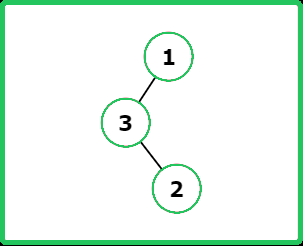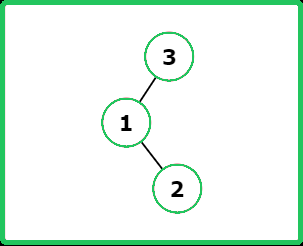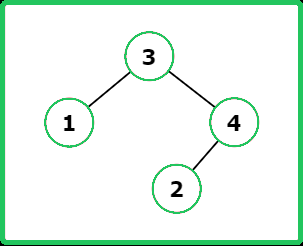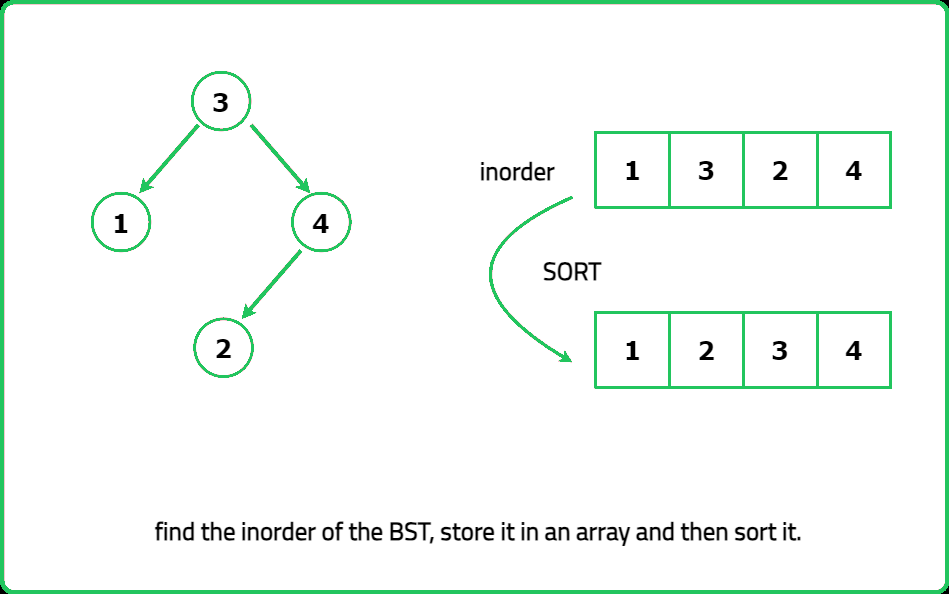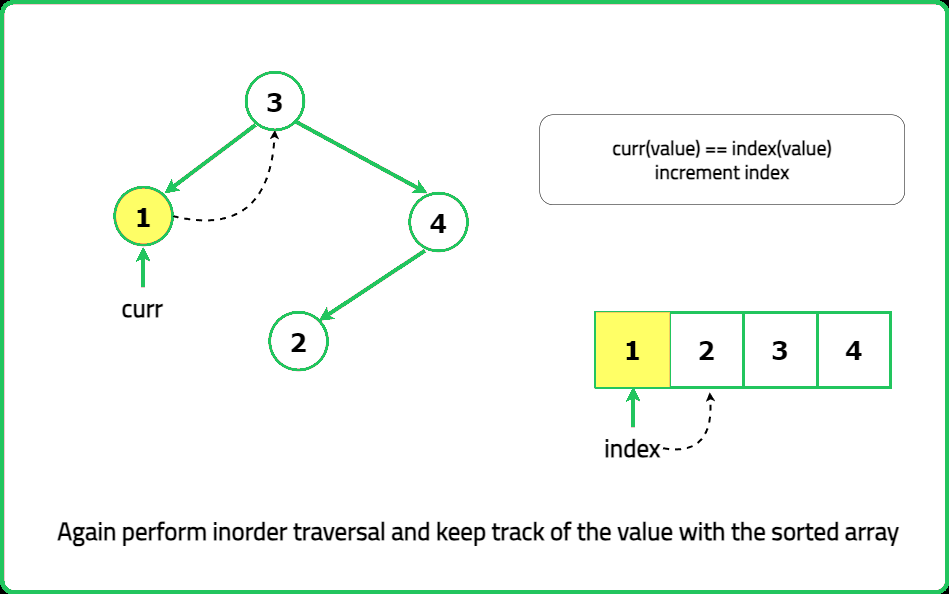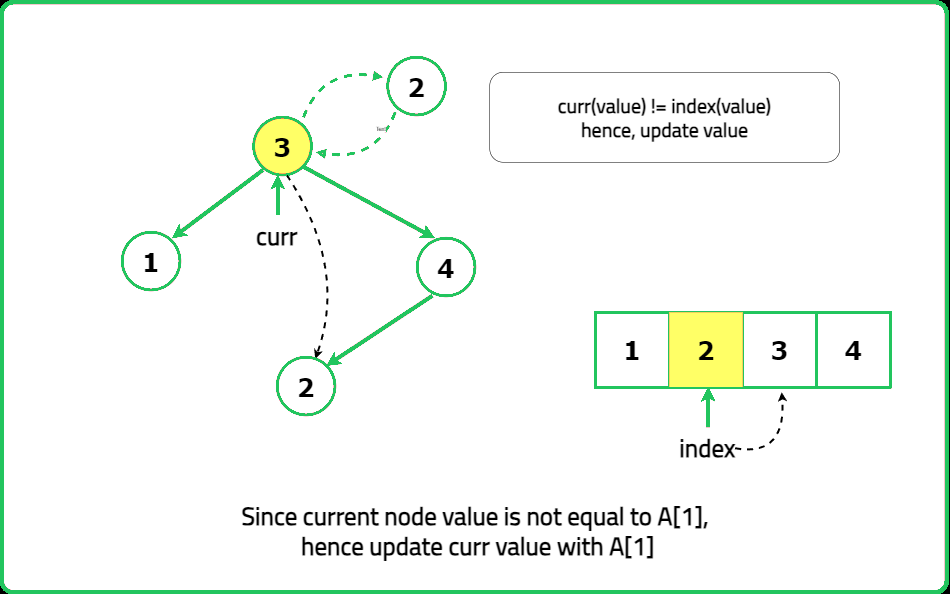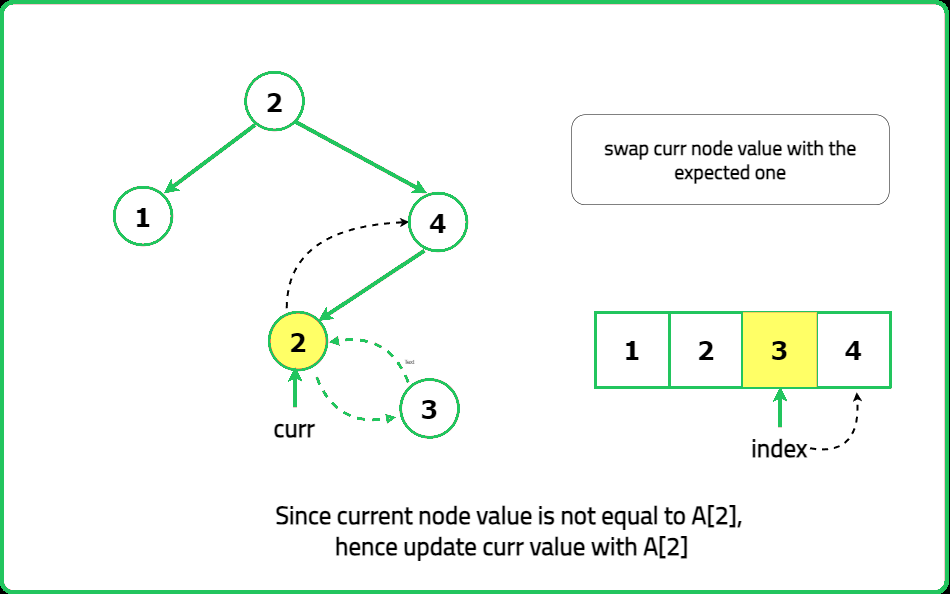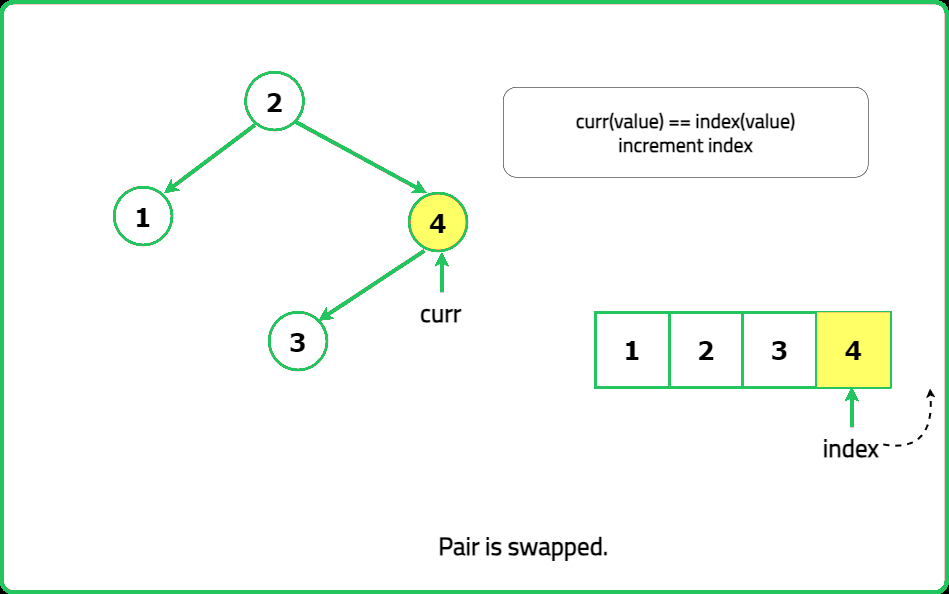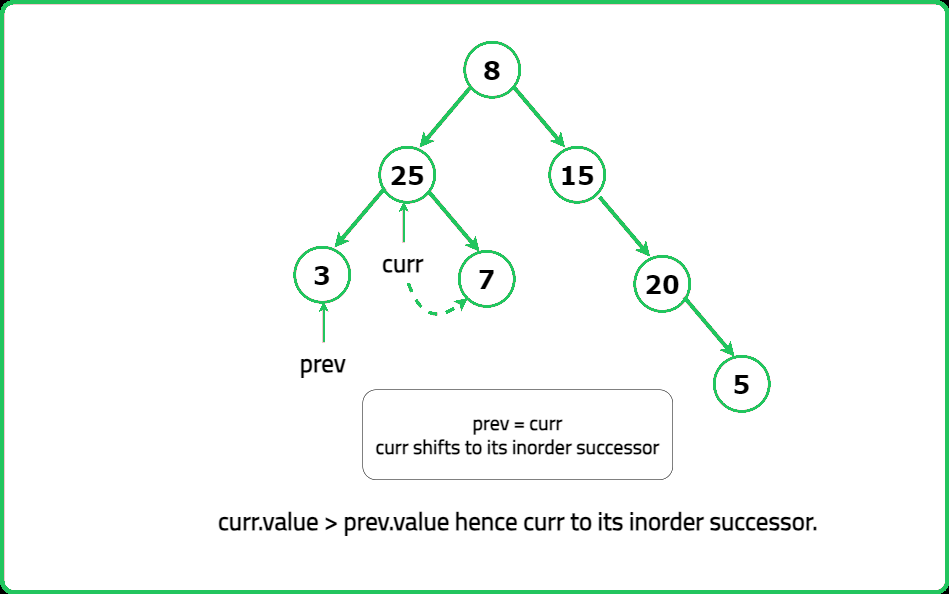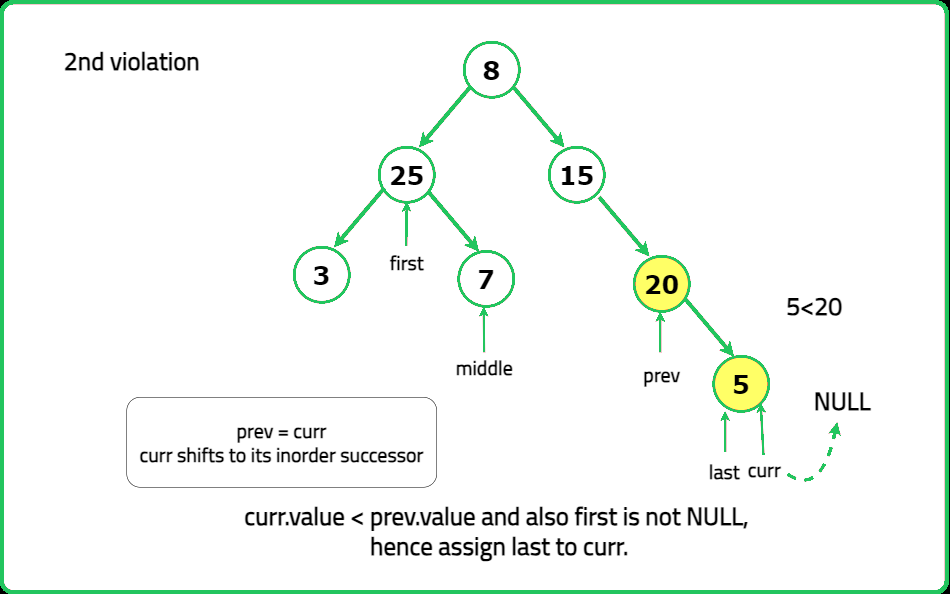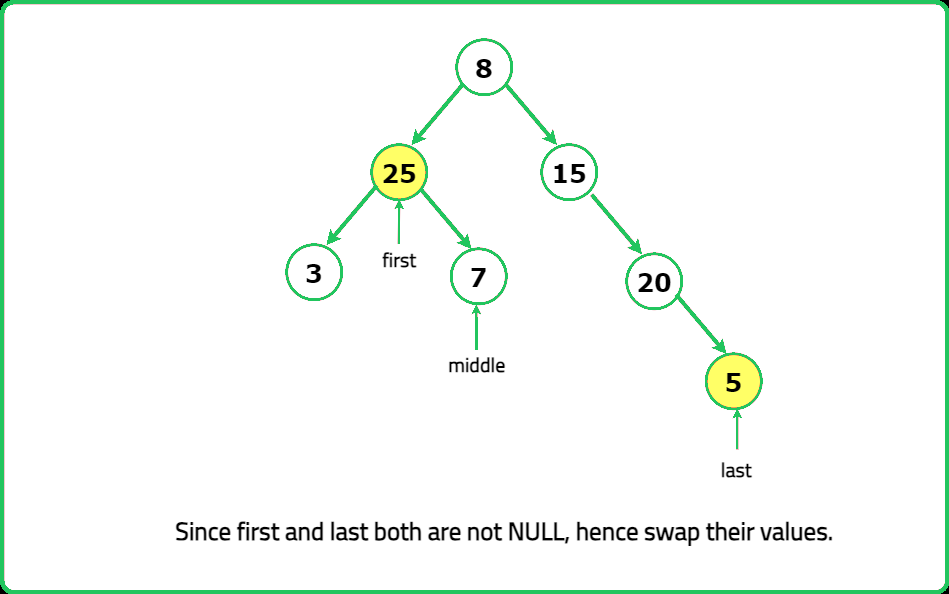12345678910111213141516171819202122232425262728293031323334353637383940414243444546474849505152535455565758596061626364656667686970717273747576777879808182838485
#include <bits/stdc++.h>
using namespace std;
/**
* Definition for a binary tree node.
*/
struct TreeNode {
int data;
TreeNode *left;
TreeNode *right;
TreeNode(int val) : data(val), left(nullptr), right(nullptr) {}
};
class Solution {
public:
void recoverTree(TreeNode* root) {
TreeNode *first = nullptr, *middle = nullptr, *last = nullptr, *prev = nullptr;
// Helper function for inorder traversal
function<void(TreeNode*)> inorder = [&](TreeNode* node) {
if (!node) return;
// Traverse the left subtree
inorder(node->left);
// Identify the nodes that are out of order
if (prev && prev->data > node->data) {
if (!first) {
first = prev; // First out-of-order node
middle = node; // Middle node in case nodes are adjacent
} else {
last = node; // Last out-of-order node
}
}
prev = node; // Update prev node to the current node
inorder(node->right); // Traverse the right subtree
};
inorder(root); // Perform the inorder traversal to find the two nodes
// Correct the BST by swapping the misplaced nodes
if (first && last) {
swap(first->data, last->data); // Non-adjacent nodes
} else if (first && middle) {
swap(first->data, middle->data); // Adjacent nodes
}
}
};
// Helper function to insert nodes in the tree for testing purposes
TreeNode* insertLevelOrder(vector<int>& arr, int i) {
if (i >= arr.size() || arr[i] == -1) return nullptr;
TreeNode* root = new TreeNode(arr[i]);
root->left = insertLevelOrder(arr, 2 * i + 1);
root->right = insertLevelOrder(arr, 2 * i + 2);
return root;
}
// Helper function to print inorder traversal of the tree
void inorderPrint(TreeNode* root) {
if (root) {
inorderPrint(root->left);
cout << root->data << " ";
inorderPrint(root->right);
}
}
int main() {
// Example input tree: [1, 3, -1, -1, 2]
vector<int> nodes = {1, 3, -1, -1, 2};
TreeNode* root = insertLevelOrder(nodes, 0);
// Solution instance
Solution sol;
sol.recoverTree(root);
// Print corrected tree
inorderPrint(root);
return 0;
}
1234567891011121314151617181920212223242526272829303132333435363738394041424344454647484950515253545556575859606162636465666768697071727374
/**
* Definition for a binary tree node.
*/
public class TreeNode {
int data;
TreeNode left;
TreeNode right;
TreeNode(int val) { data = val; left = null; right = null; }
}
class Solution {
private TreeNode first = null, middle = null, last = null, prev = null;
public void recoverTree(TreeNode root) {
inorder(root); // Perform inorder traversal to identify the misplaced nodes
// Correct the BST by swapping the misplaced nodes
if (first != null && last != null) {
int temp = first.data;
first.data = last.data;
last.data = temp;
} else if (first != null && middle != null) {
int temp = first.data;
first.data = middle.data;
middle.data = temp;
}
}
private void inorder(TreeNode node) {
if (node == null) return;
// Traverse the left subtree
inorder(node.left);
// Identify the nodes that are out of order
if (prev != null && prev.data > node.data) {
if (first == null) {
first = prev; // First out-of-order node
middle = node; // Middle node in case nodes are adjacent
} else {
last = node; // Last out-of-order node
}
}
prev = node; // Update prev node to the current node
// Traverse the right subtree
inorder(node.right);
}
// Main method to demonstrate the solution
public static void main(String[] args) {
// Example input tree: [1, 3, null, null, 2]
TreeNode root = new TreeNode(1);
root.left = new TreeNode(3);
root.left.right = new TreeNode(2);
// Solution instance
Solution sol = new Solution();
sol.recoverTree(root);
// Helper function to print inorder traversal of the tree
inorderPrint(root);
}
private static void inorderPrint(TreeNode root) {
if (root != null) {
inorderPrint(root.left);
System.out.print(root.data + " ");
inorderPrint(root.right);
}
}
}
123456789101112131415161718192021222324252627282930313233343536373839404142434445464748495051525354555657585960616263646566676869707172737475767778
# Definition for a binary tree node.
class TreeNode:
def __init__(self, val=0, left=None, right=None):
self.data = val
self.left = left
self.right = right
class Solution:
def __init__(self):
# Initialize the pointers
self.first = None
self.first_next = None
self.last = None
self.previous_node = TreeNode(float('-inf')) # Previous node initialized to negative infinity
def inorderTraversal(self, root: TreeNode):
if not root:
return
# Traverse the left subtree
self.inorderTraversal(root.left)
# Identify misplaced nodes
if self.previous_node and root.data < self.previous_node.data:
if not self.first:
self.first = self.previous_node # First out-of-order node
self.first_next = root # Node next to the first out-of-order node
else:
self.last = root # Second out-of-order node
# Update previous node to current node
self.previous_node = root
# Traverse the right subtree
self.inorderTraversal(root.right)
def recoverTree(self, root: TreeNode):
# Reset the pointers
self.first = self.first_next = self.last = None
self.previous_node = TreeNode(float('-inf'))
# Perform the inorder traversal to find the two nodes
self.inorderTraversal(root)
# Correct the BST by swapping the misplaced nodes
if self.first and self.last:
self.first.data, self.last.data = self.last.data, self.first.data # Non-adjacent nodes
elif self.first and self.first_next:
self.first.data, self.first_next.data = self.first_next.data, self.first.data # Adjacent nodes
# Helper function to insert nodes in the tree for testing purposes
def insertLevelOrder(arr, i):
if i >= len(arr) or arr[i] is None:
return None
root = TreeNode(arr[i])
root.left = insertLevelOrder(arr, 2 * i + 1)
root.right = insertLevelOrder(arr, 2 * i + 2)
return root
# Helper function to print inorder traversal of the tree
def inorderPrint(root):
if root:
inorderPrint(root.left)
print(root.data, end=' ')
inorderPrint(root.right)
if __name__ == "__main__":
# Example input tree: [1, 3, None, None, 2]
nodes = [1, 3, None, None, 2]
root = insertLevelOrder(nodes, 0)
# Solution instance
sol = Solution()
sol.recoverTree(root)
# Print corrected tree
inorderPrint(root)
12345678910111213141516171819202122232425262728293031323334353637383940414243444546474849505152535455565758596061626364656667686970717273747576777879808182838485868788899091929394
/**
* Definition for a binary tree node.
*/
class TreeNode {
constructor(val = 0, left = null, right = null) {
this.data = val;
this.left = left;
this.right = right;
}
}
class Solution {
constructor() {
// Initialize the pointers
this.first = null;
this.firstNext = null;
this.last = null;
this.previousNode = new TreeNode(Number.NEGATIVE_INFINITY); // Previous node initialized to negative infinity
}
inorderTraversal(node) {
if (!node) return;
// Traverse the left subtree
this.inorderTraversal(node.left);
// Identify misplaced nodes
if (this.previousNode && node.data < this.previousNode.data) {
if (!this.first) {
this.first = this.previousNode; // First out-of-order node
this.firstNext = node; // Node next to the first out-of-order node
} else {
this.last = node; // Second out-of-order node
}
}
// Update previous node to the current node
this.previousNode = node;
// Traverse the right subtree
this.inorderTraversal(node.right);
}
recoverTree(root) {
// Reset the pointers
this.first = this.firstNext = this.last = null;
this.previousNode = new TreeNode(Number.NEGATIVE_INFINITY);
// Perform the inorder traversal to find the two nodes
this.inorderTraversal(root);
// Correct the BST by swapping the misplaced nodes
if (this.first && this.last) {
[this.first.data, this.last.data] = [this.last.data, this.first.data]; // Non-adjacent nodes
} else if (this.first && this.firstNext) {
[this.first.data, this.firstNext.data] = [this.firstNext.data, this.first.data]; // Adjacent nodes
}
}
}
// Helper function to insert nodes in the tree for testing purposes
function insertLevelOrder(arr, i) {
if (i >= arr.length || arr[i] === null) return null;
const root = new TreeNode(arr[i]);
root.left = insertLevelOrder(arr, 2 * i + 1);
root.right = insertLevelOrder(arr, 2 * i + 2);
return root;
}
// Helper function to print inorder traversal of the tree
function inorderPrint(root) {
if (root) {
inorderPrint(root.left);
process.stdout.write(root.data + ' ');
inorderPrint(root.right);
}
}
// Main function to demonstrate the solution
const main = () => {
// Example input tree: [1, 3, null, null, 2]
const nodes = [1, 3, null, null, 2];
const root = insertLevelOrder(nodes, 0);
// Solution instance
const sol = new Solution();
sol.recoverTree(root);
// Print corrected tree
inorderPrint(root);
};
main();
